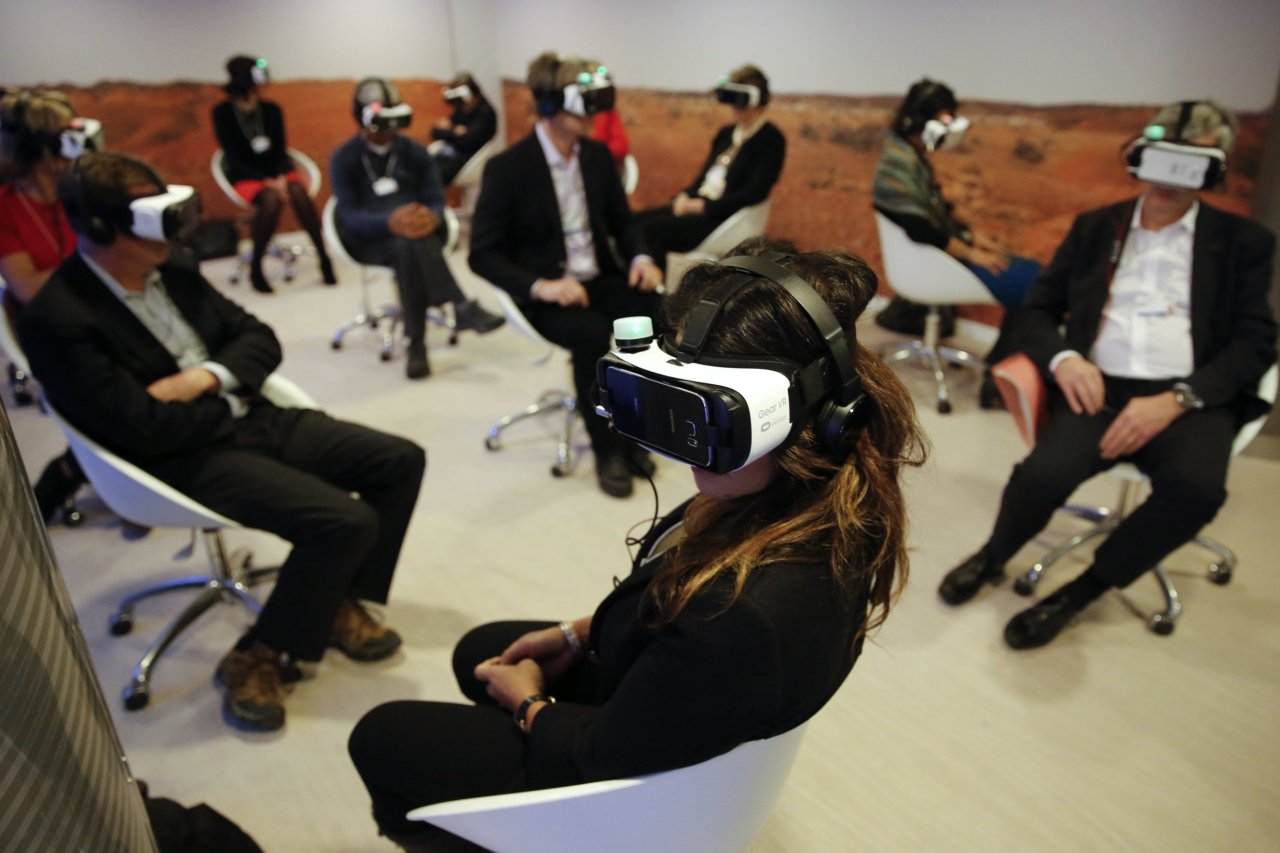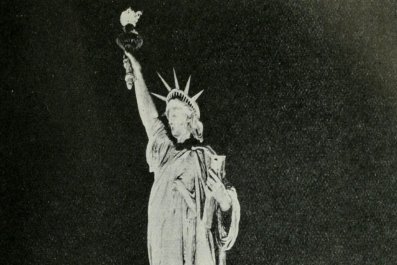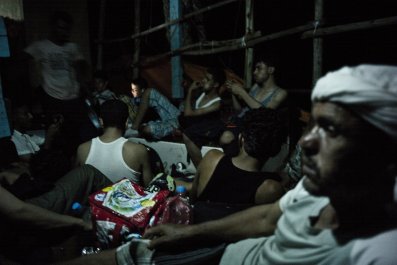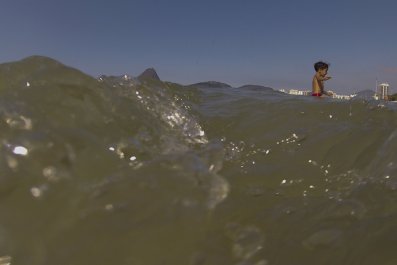Terrorism and technology will make joining a crowd seem as outmoded and perilous as getting in a fistfight, or having sex for the first time on your wedding night.
To be clear, we're talking about actual crowds—the kind where hundreds or thousands of flesh-and-blood people converge on a physical place for fun or to make a point. But if crowds end up in the dustbin with coffee percolators and cloth diapers, it will happen because the risk and cost of joining a crowd are forcing us to consider alternatives at a time when alternatives seem good enough to satisfy our needs. And that moment is about to land. Actual crowds will soon be replaced by what we might call distributed crowds.
Emerging virtual reality and augmented reality technologies will make that possible—not unlike the way big-screen TVs and streaming movies have made it possible to enjoy films yet never go to a theater.
In most of the world, deaths from wars are at historic lows, and we're much less likely than ever to go into battle. But it increasingly seems like the battle is coming to us, and crowds are a preferred target. Terrorism—or at least the spread of random mass killings—is certainly raising the perceived risk and cost of joining a crowd. As thousands gathered to watch Bastille Day fireworks in Nice, France, a lone nutjob plowed through with a truck, killing 84. In Orlando, Florida, hundreds were dancing in a nightclub when another nutjob opened fire with automatic weapons, killing 49. At the packed airport in Istanbul, three attackers killed a group of 41 people.
This kind of news seems relentless, and the targets could be anyplace, so we're already wondering about safety in any crowd, whether it's as high-profile as New Year's Eve in New York's Times Square or just a concert or sporting event or mall or parade in a small town. As authorities insist on heightening security by setting up safety stops, roadblocks and metal detectors, they make joining a crowd time-consuming and difficult—yet more reasons to stay away. On top of all that, Brazil has managed to mix in other factors like the Zika virus and political instability, and the result is a boatload of good reasons for thousands of Olympics fans to skip joining those crowds.
If such trends continue—and there's no reason to think they won't—more people will start avoiding crowds. Many will look for another way to satisfy their desire to share an experience with other people. This is where technology comes in.
Not long ago, virtual reality and augmented reality was the stuff of Star Trek movies and the geekiest of geeks. But Oculus Rift, which Facebook bought in 2014 for $2 billion, released its first VR headset in March. For the first time, VR has become good enough to make you feel like you're in another place, like on a frozen tundra or aboard a spaceship. An Oculus adventure still looks like a videogame, but technologists can see a pathway to realistic virtual worlds. Now money and talent are avalanching into VR. By one estimate, startups and major companies such as Facebook, Microsoft, HTC and Google have spent more than $2 billion developing VR in the past year, and the advances are coming quickly. "What I thought would take 10 years got condensed into something like one or two," says Eugene Chung, who left Oculus to launch VR startup Penrose Studios.
I've talked to sports team owners who think this is the future of pro sports. Don a headset and watch a baseball game from the dugout. Move your eyes or head to follow the action, and it will seem little different from real life, except that cold beer won't cost $14. If you could watch a game that way, why go to the stadium, fight your way through the parking lot and sit in sky-high seats on a 90-degree day?
Imagine VR versions of concerts, or the Bastille Day fireworks. And with a company like Facebook involved, there's a social element coming. Eventually, you won't be alone in VR. You'll look around and see other people at the same event and be able to talk to them. The shared experience will come to you instead of you going to it. Instead of wondering if a crazed gunman is in your midst, you'd just have to worry about tripping over your cat.
Some believe augmented reality will have an even bigger impact. AR blends the real world around you with virtual images or information. Pokémon Go is the crudest of crude versions of AR, but it's introducing millions of people to the concept. The game, played on a smartphone, places Pokémon characters in real-world settings, so you might look at your screen and see a Squirtle in a nearby hotel's pool.
The truly amazing AR will come from companies like Magic Leap. Its technology is how you'll eventually sit at a conference table, put on a pair of AR glasses and have a meeting with beautifully rendered full-size versions of your colleagues from around the world as they appear to sit in the other chairs pretending to pay attention while texting under the table just like in real life.
VR and AR can change the nature of protest crowds. In 1989, thousands gathered in Beijing's Tiananmen Square to protest authoritarian rule. While that mass of people got the world's attention, it also made the protesters an easy, concentrated target when Chinese troops moved in. The next generation might instead rely on AR. Millions of people—alone or in small groups—might go to their town squares at the same time and through AR see and interact with throngs of others seeming to stand in that same place. Sympathizers from all over the planet could stand with them. The crowd could be gigantic, yet distributed so that no head-on attack could take it down.
Would such a virtual, distributed crowd have the same level of emotional and political impact? Some experts think so. The key to a crowd is not occupying a space but rallying passions and getting attention. All that's required, wrote Robert Kaplan in Global Affairs, is "the knowledge that you are not alone against a hated regime but have virtual supporters worldwide." That brings "a lift in morale that, in turn, brings along with it courage and a sense of empowerment. Inside a crowd you are protected, for your passions are those of the person next to you, and the next, all flowing together." The person next to you has to be able to connect with you just as he or she might in a real setting, but if the technology makes that work, then there might not be any reason the protesters have to physically be in the same place.
Of course, if crowds become obsolete, it will raise challenges for the physical world. Would sports be the same if teams played in empty stadiums, all their fans virtually watching? What about the bonding function of crowds in cities? Going to the fireworks in Nice has long helped residents feel a part of their community and country. That kind of bonding is the critical role of events in towns around the world. Hard to see how organizers of the Clinton, Montana, Testicle Festival will manage to host their Undie 500 race in VR.
But then again, I'd be more likely to join in if they do.






















